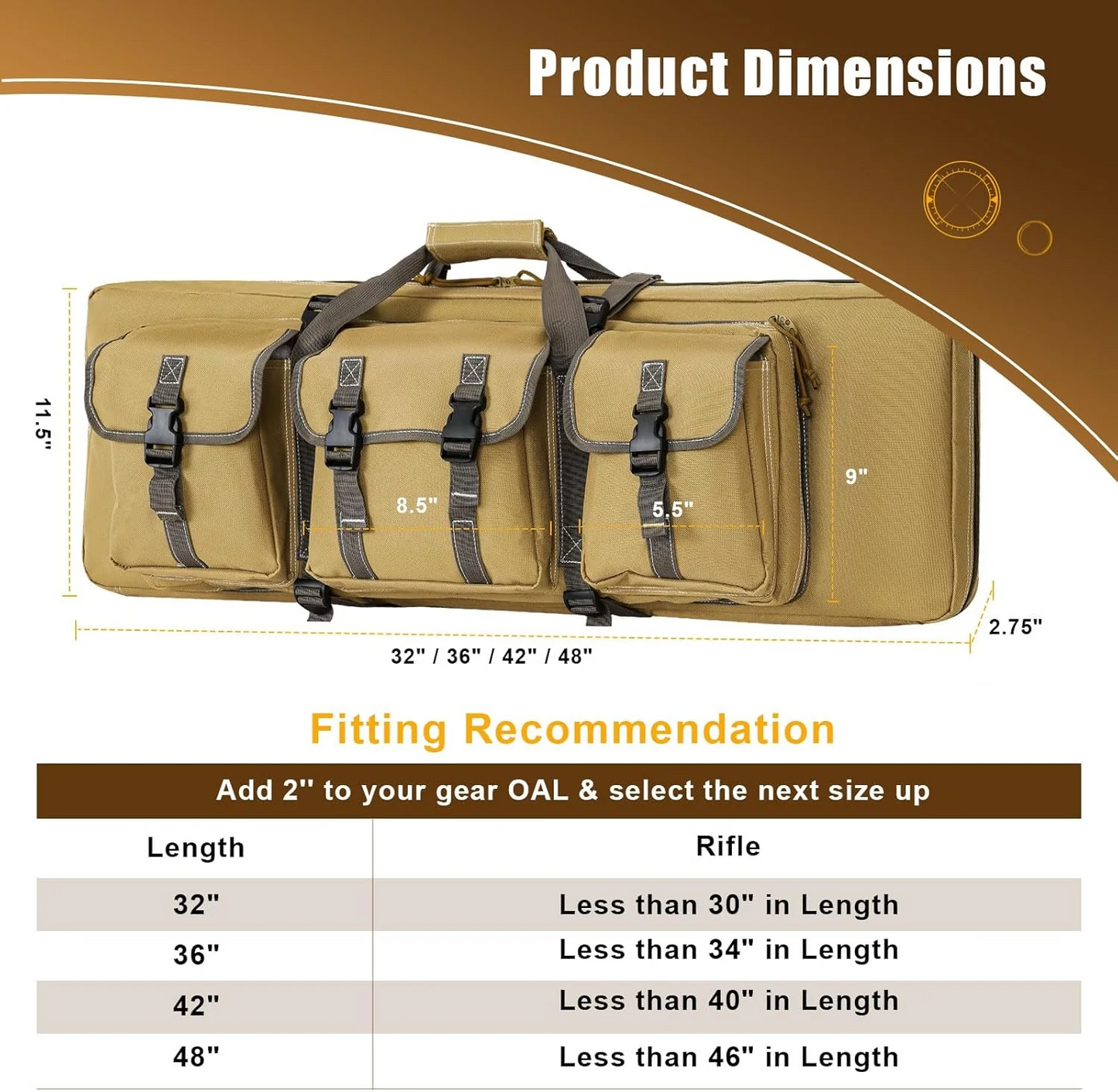
Sizing gun cases and tactical backpacks correctly is more than a personal choice—it is a critical selection that has direct implications on protecting, functionality, and the overall lifespan of your valuable equipment. Inaccurately sized storage areas can lead to equipment damage from excessive movement, reduced protection, and increased susceptibility to outside conditions. Beyond protection, sizing accurately also enhances mobility, allowing easier transport while also having immediate accessibility when needed. Taking uninformed sizing choices usually means unnecessary costs as replacements become unavoidable, making proper sizing knowledge your top priority before making any purchase.
How to Apply Dimensional Measurements for Tactical Backpacks

📏 Measure Twice, Purchase Once
The foundation of selecting correctly sized tactical backpack begins with precise measurements. Follow these steps for accuracy:
- Length Measurement: Measure your firearm from end to end, including any attachments that are not detachable.
- Width Assessment: Measure at the widest point, typically across the action or grip.
- Height Verification: Measure from the bottom of the magazine or grip to the highest point.
Don't forget to include attachments! A common error is not accounting for additional room for:
- Scopes and optics (+2-3 inches in height)
- Extended magazines (+1-2 inches in length)
- Tactical lights and lasers (+1 inch in width)
⚠️ Pro Tip: Use a soft measuring tape rather than a rigid ruler for more accurate measurements of curved surfaces.
The "One-Size-Fits-All" Fallacy About Tactical Backpack
You'll see plenty of tactical backpacks advertised as "one-size-fits-all," but honestly, that approach usually falls short. Here’s why:
- Generic Isn't Specific Enough: A pack designed to maybe hold a small handgun just won't cut it for a tactical rifle loaded with accessories. You lose the specific fit your gear needs.
- Your Needs Are Unique: How you plan to use the pack, the exact gear you carry, and even just your personal preference mean you need something tailored to you.
- Better Protection with the Right Fit: A backpack or case specifically chosen or designed for your equipment provides much better support and protection, right where it counts.
🎯 Finding What Actually Works for You
Instead of just grabbing a generic pack because it seems easy, take a minute to figure out what you really need:
- What’s the biggest piece of gear you need to carry?
- How much other stuff (accessories, supplies) needs to fit in there too?
- Where will you mostly be using this pack (city, woods, travel)?
Answering these questions will point you toward a pack that truly fits your situation, rather than settling for a "one-size" option that probably won't be great for anything specific.
How to Distribute the Weight in Tactical Backpack
How you pack your tactical backpack makes a huge difference in comfort and how easily you can move, especially if you're carrying it for a while. Getting the weight distribution right can be the key to a good trip versus a painful one.
⚖️ Balancing Your Gear and Your Body
- The 80/20 Guideline: Aim to have about 80% of the pack's weight resting on your hips, not your shoulders. Your shoulders should only carry about 20%.
- Center of Gravity is Key: Place heavier items closer to your back and centered between your shoulder blades. This helps you keep your balance.
- Smart Vertical Packing: Put things you'll need often closer to the top of the pack so you can grab them easily without messing up the balance too much.
Keep in mind that different body types might need slightly different adjustments. Taller folks might find higher attachment points for shoulder straps more comfortable, while shorter people often do better with more compact packs that have highly adjustable harnesses.
Here's how to put it into practice:
- Adjust the shoulder straps so the pack sits high on your back.
- Tighten the hip belt snugly – this is what transfers the weight off your shoulders and onto your stronger hip muscles.
- Use the compression straps on the outside of the pack to cinch everything down. This keeps the load stable and prevents things from shifting around inside.
Material and Durability Trade-offs in Tactical Backpack
Material selection directly impacts case and backpack size and protection. Therefore, there are inherent trade-offs that must be thoroughly considered.
🛡️ Material Matters: Protection vs. Portability
Hard Cases:
- Injection-Molded Polymer: Gives great protection and isn't overly heavy.
- Aluminum: Offers top-notch protection but weighs more.
- Composite Materials: A good balance of protection and weight, but usually cost more.
Soft Cases and Backpacks:
- 1000D+ Nylon (like Cordura): Very resistant to tears and abrasion, fairly standard weight.
- Ballistic Nylon: Extra durable, but a bit heavier.
Another thing to consider is padding thickness. Every extra bit of foam adds bulk and weight, but it also gives crucial cushioning against bumps and drops.
💡 Think About This: How will you usually be carrying your gear? If you're mostly driving, you can probably handle a larger, heavier, more protective case. If you're walking or using public transport, you'll likely want something lighter and smaller.
Accessibility vs. Security Dilemma in Tactical Backpack
Finding the right balance between getting to your gear quickly and keeping it secure is a big part of choosing the right size pack.
🔒 Quick Access or Maximum Security?
If getting to your gear fast is the priority:
- A slightly larger pack or compartment can make grabbing items quicker.
- Simpler buckles or closure systems can shave off precious seconds.
- Well-organized compartments let you find things without digging.
If keeping things locked down is more important:
- A snugger fit prevents items from shifting and makes unauthorized access harder.
- Multiple layers of security (like double zippers, internal straps) offer more protection.
- Adding locks obviously increases security, but also adds bulk and weight.
This balance really matters depending on the situation:
- Home Defense: You need immediate access.
- Travel: Security regulations (like for flights) often demand secure storage.
- Field Use: You often need a mix of both – keeping gear secure while still being able to reach essentials reasonably quickly.
How to Plan Today for Tomorrow's Tactical Backpack
Perhaps the most overlooked aspect of sizing decisions is to leave room for future equipment acquisition. Consider these strategies:
Modular Systems Advantages:
- Expandable compartments grow with your collection
- Attachment points accommodate additional pouches and accessories
- Swappable pieces adapt to new demands
Room for Growth Strategy:
- Select cases approximately 10-15% larger than current needs
- Prioritize adjustable internal dividers and customizable foam
- Consider systems with expansion capabilities built into their design
Investing in marginally larger, modular systems generally pays off by lengthening the useful life of your storage solutions and allowing for inevitable equipment upgrades.
How to Choose the Right Tactical Backpack Size for Your Environment
Selecting the appropriate size for your tactical backpack depends heavily on where and how you plan to use it. Consider the following scenarios to ensure you're equipped with the best pack for your needs: In the City:
- Slimmer packs make it easier to move through crowds and tight spaces
- A low-key look helps avoid drawing unwanted attention
- Lighter options are much easier to handle when using buses or subways
Out in the Wilderness:
- You'll need more space to carry essential survival gear
- Weather-resistant materials can add some bulk, but that protection is crucial
- Greater capacity to support longer field operations
Dealing with Weather:
- Cold: Make sure you have enough room for extra insulated layers
- Wet: Look for packs with good waterproofing
- Hot: Ventilation features become really important for staying comfortable
How to Choose Tactical Backpack Size According to Legal and Travel Regulations
Travel, and especially flying, entails dealing with laws about equipment size and how certain things need to be packed. This definitely plays a role with choosing the right backpack.
Flying Considerations:
- Carry-On: If you're planning on bringing your pack on the plane, make sure that it meets today's TSA size regulations
- Checked Bags: Weight and size restrictions for checked bags are also set by airlines, so keep that in mind if you're checking your pack
- Special Items: Shipping specialty items like firearms involves special, locked hard cases complying with airline and TSA standards. Consider how packing these separate cases might affect your overall luggage layout
Driving Across State Lines:
- Varying State Laws: Rules for transporting certain gear can differ quite a bit from state to state, sometimes impacting where items must be stored in your vehicle.
- Vehicle Storage: Your pack's size will obviously affect where it fits securely and legally in your car (like the trunk vs. the back seat).
- Staying Low-Profile: A smaller, less attention-grabbing pack can be helpful during necessary stops on the road.
⚠️ Critical Reminder: Rules change often! Always double-check the latest TSA, airline, and state regulations before you head out.
Protect Your Investment With Perfect Sizing
Choosing the right size for gun cases and tactical packs is a crucial decision that has implications on protection, functionality, and conformity. By making exact measurements of your equipment, foreseeing your demands, and knowing the exact scenarios under which you will use your equipment, you can make functional decisions that enhance safety and happiness. Remember that investing time in selecting properly sized storage solutions ultimately protects your valuable equipment while providing the confidence that comes from knowing your gear is properly secured, readily accessible, and legally compliant wherever your activities take you.
